Depiction of Language at the Interface Between Thought and Sound
Item
-
Title
-
Depiction of Language at the Interface Between Thought and Sound
-
Description
-
Against the floating realm of thought, would sounds by them- selves yield predelimited entities? No more so than ideas. Phonic substance is neither more fixed nor more rigid than thought; it is not a mold into which thought must of necessity fit but a plastic substance divided in turn into distinct parts to furnish the signifiers needed by thought. The linguistic fact can therefore be pictured in its totality—i.e. language—as a series of contiguous subdivisions marked off on both the indefinite plane of jumbled ideas (A) and the equally vague plane of sounds (B). [This] diagram gives a rough idea of it.
The characteristic role of language with respect to thought is not to create a material phonic means for expressing ideas but to serve as a link between thought and sound, under conditions that of necessity bring about the reciprocal delimitations of units. Thought, chaotic by nature, has to become ordered in the process of its decomposition. Neither are thoughts given material form nor are sounds transformed into mental entities; the somewhat mysterious fact is rather that "thought-sound" implies division, and that language works out its units while taking shape between two shapeless masses. Visualize the air in contact with a sheet of water; if the atmospheric pressure changes, the surface of the water will be broken up into a series of divisions, waves; the waves resemble the union or coupling of thought with phonic substance.
-
Designer
-
de Saussure, Ferdinand
-
Date
-
1959
-
Bibliographic Citation
-
de Saussure, F. (1959). Course in General Linguistics. (W. Baskin, trans.). Bloomsbury. (Original work published 1916).

